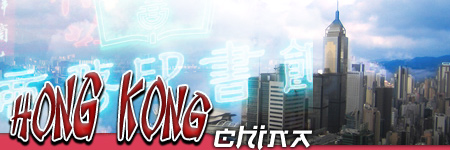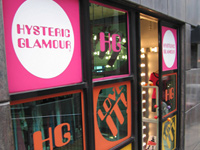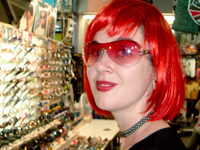
Get Lost in Hong Kong's Modernized Chaos
by
Amanda
Castleman
Glitz and grit collide in the Fragrant
City. This cosmopolitan consumeropolis was once a pirate outpost,
then a port trading in tea, silk and opium. From a barren
rock, Hong Kong grew into one of the world’s densest
cities with seven million residents.
Hong
Kong is a city of twittering helicopters and well-kept women. “Hysteric Glamour,” chirps one storefront, smothered
in hot pink, mustard and orange decals. “Love it!”
 |
|
Hysteric
Glamour, a shop in Central, sums up Hong Kong’s
ethos. |
And they do. O how they love that hysteric glamour. From the vendors of sweatshopped cell-phones to the “tai tais”, those ladies who lunch, the Pearl of the Orient is all about face: how deluxe the car, how designer the couture, how deep the ceremonial bow.
The consumer culture is contagious. I find myself in a night market, lit by lurid neon. Rain tattoos the tarps, strung over tee shirts of Mao and Hello Kitty. Electronics snarl together on the folding tables. Everything seems shoddy, including the scarlet synthetic wig and pink aviators I buy on a whim.
I hit the dance floor in my “Alias” disguise. At 5’7’’, I’m an Amazon here: not quite Jennifer Garner, but certainly noticeable. We slink the alleys of Lan Kwai Fong, Central’s nightclub district. Jackie Chan and Zhang Zi Yi aren’t at the Dragon-i tonight, so patrons are left speculating about my bright red bob and silly sunglasses. Eventually, we close down the trendy lounge, sodden after sake cocktails and cheesy salsa moves.
I’m not the first foreigner to succumb to products and posturing here. Jan Morris described the colonizers in her travel classic “Hong Kong”: “often [they] seem to be pursuing their careers in a pleasant state of half-speed-ahead, eating well, enjoying their friends, gossiping in the club bar, taking the junk out on Sundays.”
Christopher New was far more damning in his novel “The Chinese Box”, twisted into a 1997 film by Wayne Wang. The bestselling author – and HK resident for nearly three decades – described the city as a drainage system for the country’s capitalists. “Every one of them worshipped the golden calf with brutal enthusiasm,” he wrote, “hoping only for enough time to fill a foreign bank account before the communists at last swept over the Kowloon hills and in their own no less brutal style stamped out the cult and replaced it with their own.”
Of course, the expat scene is fading, after the handover. The Brits’ 99-year lease expired on the commercial outpost of Hong Kong. China resumed control of this special administrative region in 1997. Little has changed, locals reassure guests, except the exodus of the “gweilo”, which translates either as white “ghost people” or “foreign devils”, depending on your mood.
 |
Author
in her Alias disguise at a Kowloon night market. |
Locals now fill the racetrack terraces and Rolls Royces in this 98-percent Chinese city, dominated by the Cantonese. Western wallets are still welcome, however. The tourism board has been “heavily advocating the proper treatment of tourists, asking citizens not to rip them off when they are purchasing electronic goods,” reports the “South China Morning Post”.
Old habits die hard, it seems. This cosmopolitan consumeropolis was once a pirate outpost, then a port trading in tea, silk and opium. From a barren rock, Hong Kong grew into one of the world’s densest cities with seven million residents in 1,100 square km. Whenever space grows too tight, dirt trucks arrive from the New Territories. Such “reclamation” has already reduced the bay to nearly half its original size.
Victoria, the vanishing harbor, is a frantic mosaic of sampans, ferries, pleasure crafts, fishing boats and ocean-going freighters. Nature wreathes the mouth of the Pearl River Delta, the portal between China and the Pacific. As Morris wrote, “it is more than a city actually, being an archipelago of some 235 rocks and islands attendant upon a squat mountainous peninsula.” Indeed, Hong Kong is highly concentrated: 70 percent of the region remains blanketed in forests, farmland and country parks.
Skyscrapers girdle the circuit-board center, humming with deals and deadlines amid the hot smog. The globe’s fifth tallest building, Two International Finance Centre, soars 88 stories here. Nearby looms IM Pei’s legendary Bank of China tower (featured on the HK$20 bill, but nonetheless considered to have feng shui so wicked that a leader reduced the nearby Government House to a society-party shell).
Mirrored glass – not just blue, but pink and gold and green – reflects the sultry light of the South China Sea. Big thunderclouds boil across this neon-swathed cityscape. Brooding and quicksilver, Hong Kong sometimes resembles Gotham in a Batman noir … with Bladerunner highlights offset by the beatific smile of a 110-foot bronze Buddha at Po Lin Monastery.
Glitz and grit collide in Hong Kong. Television aerials blacken the sky like sharp Chinese pictographs. Topless dancers, tailors and pirated-DVD touts jostle in Kowloon. Laundry festoons water-stained concrete tower blocks, where entire families squash into 10x10 apartments. Corrugated iron shanties cluster on the outskirts, near the duck farms and oyster beds. The poor and posh jumble together like stir-fry in this steaming, subtropical bowl.
At the end of the day, Hong Kong is
dedicated to malls and money, not museums and manners. But the
city’s air contains a charge far beyond credit cards and
cash registers. Behind the right pair of sunglasses, it takes
on a rosy glow. Hysteric Glamour. Love it!
IF
YOU GO ... |
The
Hong Kong Tourism Board offers junk rides, tai chi and
Chinese medicine classes, among the wealth of giddy
event announcements and civic boosterism (9th-11th floor,
Citicorp Centre, 18 Whitfield Road, North Point; plus
offices at the Causeway Bay MTR station and at the Star
Ferry Terminal in Kowloon; www.discoverhongkong.com).
“Time Out Hong Kong” by Lesley
McCave remains the best guide, backed by Jan Morris’
epic travelogue “Hong Kong: Epilogue to an Empire”.
Where to stay
The exquisite Island Shangri-la showcases the world’s
largest indoor mural: the silk-painting Great Motherland
of China stretches 16 floors. Ignore the lower level
mall and be dazzled by the bay views in HK’s tallest
hotel – or the 769 crystal chandeliers, brightening
this haven for businesspeople, upscale tourists and “tai tais”. The lean tower slices over
Victoria Harbour, just beside IM Pei’s legendary
Bank of China tower. The bewildering international buffet
at Café Too attracts locals, as does the posher
Petrus restaurant atop the glittering spire (Pacific
Place, Supreme Court Road, Central; 2877 3838; www.shangri-la.com).
The Peninsula Hong Kong once snapped up eight Rolls-Royces,
the largest single order ever. Ruined by a flood in
1995, all were swiftly replaced to maintain this grande
dame’s hauteur. A helipad now backs the 14 luxury
vehicles. The 1928 hotel drips glamour from the Philippe
Starck-designed bar and restaurant to the secret dance
club inside the zinc and aluminum spiral “snail’
staircase. Clark Gable introduced the screwdriver here
while filming “Soldier of Fortune” in 1953.
Bartender Johnny Chung still serves them as taught,
along with his signature lychee martinis (Salisbury
Road, Kowloon; 2920 2888 http://hongkong.peninsula.com).
Where to party
Birdcages greet guests at Dragon-i, a nightclub currently
trendy with semi-celebs and models. Scarlet lanterns
lend a sultry glow to the Red Room, a VIP lounge and
dining area (UG/F The Centrium, 60 Wyndham Street; 3110
1222; www.dragon-i.com.hk).
Its neighborhood – Lan Kwai Fong in Central
– is a good barhopping venue for Hong Kong
beginners. China Coast hipsters prefer the authenticity
of Wan Chai.
Transport
Kai Tak Airport provided the world’s most thrilling
approach until 1998. Planes skimmed low over Hong Kong’s
harbor, skyscrapers and neon signs, which were forbidden
to flash, for fear of distracting pilots. The new Chek
Lak Kok feels safer, but far more pedestrian (www.hongkongairport.com).
However, the world’s largest terminal is still
famed for its Norman Foster foyer, Rush Hour II scenes and the lavish lounges of Cathay Pacific, 2005’s
Airline of the Year, according to a Skytrax survey (1-800-233-2742
in the U.S. or 2747 1888 in Hong Kong; www.cathaypacific.com).
The Airport Express train zips from the terminal to
the city center in just 24 minutes. Hong Kong’s
public transport is a breeze, integrating a subway,
trams, the Mass Transit Railway (MTR) and Star Ferries
(2367 7065; www.starferry.com.hk).
The nine-minute, HK$2.20 trip between Kowloon and Central
is essential viewing. The city’s most eclectic
option is the mid-level escalators, a 20-minute ride
connecting Central Market with Conduit Road.
|
|